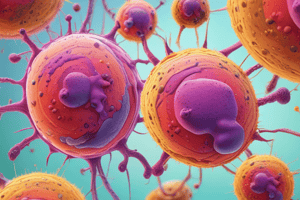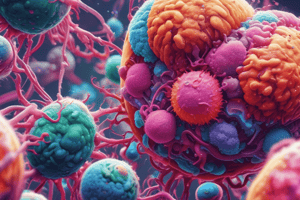Podcast
Questions and Answers
Which portal of entry is most frequently used by infectious microorganisms?
Which portal of entry is most frequently used by infectious microorganisms?
- Skin
- Gastrointestinal tract
- Respiratory tract (correct)
- Genitourinary tract
What is the primary difference between pathogenicity and virulence?
What is the primary difference between pathogenicity and virulence?
- Pathogenicity applies only to bacteria, while virulence applies to viruses.
- Pathogenicity measures toxin potency, while virulence measures infectivity.
- Pathogenicity measures the ability to cause disease, while virulence measures the degree of pathogenicity. (correct)
- There is no difference; the terms are interchangeable.
What does the term $ID_{50}$ represent in the context of microbial infection?
What does the term $ID_{50}$ represent in the context of microbial infection?
- The inhibitory dosage needed to halt microbial growth in 50% of samples.
- The incubation duration required for 50% of a population to show symptoms.
- The infecting dosage required to cause infection in 50% of a sample population. (correct)
- The immunological determinant that triggers a 50% antibody response.
What is the significance of $LD_{50}$ in microbiology?
What is the significance of $LD_{50}$ in microbiology?
How do bacterial adhesins contribute to pathogenicity?
How do bacterial adhesins contribute to pathogenicity?
Where are adhesins typically located on a bacterial cell?
Where are adhesins typically located on a bacterial cell?
What is the primary role of the bacterial capsule in pathogenesis?
What is the primary role of the bacterial capsule in pathogenesis?
How does the M protein of Streptococcus pyogenes contribute to its pathogenicity?
How does the M protein of Streptococcus pyogenes contribute to its pathogenicity?
What is the function of bacterial coagulases?
What is the function of bacterial coagulases?
How do bacterial kinases enhance virulence?
How do bacterial kinases enhance virulence?
What is the primary function of hyaluronidase in bacterial pathogenesis?
What is the primary function of hyaluronidase in bacterial pathogenesis?
Which enzyme breaks down collagen, facilitating the spread of bacteria in host tissues?
Which enzyme breaks down collagen, facilitating the spread of bacteria in host tissues?
What is antigenic variation, and why is it significant in the context of infectious diseases?
What is antigenic variation, and why is it significant in the context of infectious diseases?
How do some bacteria utilize the host cell's cytoskeleton to facilitate entry into the cell?
How do some bacteria utilize the host cell's cytoskeleton to facilitate entry into the cell?
What is the role of siderophores in bacterial pathogenicity?
What is the role of siderophores in bacterial pathogenicity?
How does direct damage by bacteria differ from damage caused by bacterial toxins?
How does direct damage by bacteria differ from damage caused by bacterial toxins?
What is the primary difference between exotoxins and endotoxins?
What is the primary difference between exotoxins and endotoxins?
Which of the following is a characteristic feature of A-B toxins?
Which of the following is a characteristic feature of A-B toxins?
How do membrane-disrupting toxins cause damage to host cells?
How do membrane-disrupting toxins cause damage to host cells?
What is the primary mechanism by which superantigens cause harm to the host?
What is the primary mechanism by which superantigens cause harm to the host?
What is the function of genotoxins?
What is the function of genotoxins?
What component of gram-negative bacteria is specifically detected by the Limulus amebocyte lysate (LAL) assay?
What component of gram-negative bacteria is specifically detected by the Limulus amebocyte lysate (LAL) assay?
How can plasmids contribute to bacterial pathogenicity?
How can plasmids contribute to bacterial pathogenicity?
What is lysogenic conversion?
What is lysogenic conversion?
Aflatoxin, a carcinogenic toxin that can contaminate human food, is produced by which type of microorganism?
Aflatoxin, a carcinogenic toxin that can contaminate human food, is produced by which type of microorganism?
Some algae produce saxitoxin, a potent neurotoxin. What condition is associated with saxitoxin poisoning?
Some algae produce saxitoxin, a potent neurotoxin. What condition is associated with saxitoxin poisoning?
Which of the following is a cytopathic effect (CPE) of viral infections?
Which of the following is a cytopathic effect (CPE) of viral infections?
How do protozoa typically avoid host defenses?
How do protozoa typically avoid host defenses?
What is the primary mechanism by which helminths cause disease?
What is the primary mechanism by which helminths cause disease?
What do portals of entry and portals of exit represent in the context of infectious diseases?
What do portals of entry and portals of exit represent in the context of infectious diseases?
Which of the following enzymes is mismatched with its action in enhancing bacterial virulence?
Which of the following enzymes is mismatched with its action in enhancing bacterial virulence?
A patient develops a fever and shock due to the release of cytokines after a gram-negative bacterial infection. Which component is most likely responsible for these symptoms?
A patient develops a fever and shock due to the release of cytokines after a gram-negative bacterial infection. Which component is most likely responsible for these symptoms?
A researcher is studying a bacterium that produces a toxin which inhibits protein synthesis in nerve cells, leading to paralysis. This toxin is most likely a:
A researcher is studying a bacterium that produces a toxin which inhibits protein synthesis in nerve cells, leading to paralysis. This toxin is most likely a:
Why are toxoids used in vaccine production?
Why are toxoids used in vaccine production?
What describes the mechanism by which Salmonella species enter host cells?
What describes the mechanism by which Salmonella species enter host cells?
A bacterium produces a protein that binds tightly to iron, depriving the host of this essential nutrient. What is such a protein called?
A bacterium produces a protein that binds tightly to iron, depriving the host of this essential nutrient. What is such a protein called?
How do fungi commonly cause disease?
How do fungi commonly cause disease?
Which strategy do protozoa use to evade host defenses and cause persistent infections?
Which strategy do protozoa use to evade host defenses and cause persistent infections?
A bacterium requires a specific dose to cause infection in 50% of a test population. If this dose is relatively small, how would you characterize the microbe?
A bacterium requires a specific dose to cause infection in 50% of a test population. If this dose is relatively small, how would you characterize the microbe?
What role do bacterial capsules play in the infectious process?
What role do bacterial capsules play in the infectious process?
Which of the following best describes how hyaluronidase enhances bacterial virulence?
Which of the following best describes how hyaluronidase enhances bacterial virulence?
A bacterium produces a surface protein that triggers rearrangement of actin filaments in host cells. What is a likely outcome of this activity?
A bacterium produces a surface protein that triggers rearrangement of actin filaments in host cells. What is a likely outcome of this activity?
How do siderophores contribute to bacterial pathogenicity?
How do siderophores contribute to bacterial pathogenicity?
Which mechanisms describes how superantigens lead to disease?
Which mechanisms describes how superantigens lead to disease?
What is the role of the B component in A-B toxins?
What is the role of the B component in A-B toxins?
How do membrane-disrupting toxins typically damage host cells?
How do membrane-disrupting toxins typically damage host cells?
How do genotoxins affect eukaryotic cells?
How do genotoxins affect eukaryotic cells?
The Limulus amebocyte lysate (LAL) assay is used to detect which of the following?
The Limulus amebocyte lysate (LAL) assay is used to detect which of the following?
How can plasmids increase bacterial pathogenicity?
How can plasmids increase bacterial pathogenicity?
What is the process of lysogenic conversion?
What is the process of lysogenic conversion?
What describes the direct damage that bacteria can cause?
What describes the direct damage that bacteria can cause?
What is an example of cytopathic effects (CPE) caused by viral infections?
What is an example of cytopathic effects (CPE) caused by viral infections?
Flashcards
Pathogenicity
Pathogenicity
The ability to cause disease.
Virulence
Virulence
The degree of pathogenicity.
Portals of entry
Portals of entry
Mucous membranes, skin, parenteral route.
ID50 Definition
ID50 Definition
Signup and view all the flashcards
LD50 Definition
LD50 Definition
Signup and view all the flashcards
Adherence
Adherence
Signup and view all the flashcards
Adhesins
Adhesins
Signup and view all the flashcards
Capsules Function
Capsules Function
Signup and view all the flashcards
M protein
M protein
Signup and view all the flashcards
Opa protein
Opa protein
Signup and view all the flashcards
Waxy lipid
Waxy lipid
Signup and view all the flashcards
Coagulases
Coagulases
Signup and view all the flashcards
Kinases
Kinases
Signup and view all the flashcards
Hyaluronidase
Hyaluronidase
Signup and view all the flashcards
Collagenase
Collagenase
Signup and view all the flashcards
IgA proteases
IgA proteases
Signup and view all the flashcards
Antigenic variation
Antigenic variation
Signup and view all the flashcards
Siderophore
Siderophore
Signup and view all the flashcards
Direct damage
Direct damage
Signup and view all the flashcards
Toxins
Toxins
Signup and view all the flashcards
Toxigenicity
Toxigenicity
Signup and view all the flashcards
Toxemia
Toxemia
Signup and view all the flashcards
Intoxications
Intoxications
Signup and view all the flashcards
Exotoxins
Exotoxins
Signup and view all the flashcards
Antitoxins
Antitoxins
Signup and view all the flashcards
Toxoids
Toxoids
Signup and view all the flashcards
A-B toxins
A-B toxins
Signup and view all the flashcards
Membrane-disrupting toxins
Membrane-disrupting toxins
Signup and view all the flashcards
Superantigens
Superantigens
Signup and view all the flashcards
Genotoxins
Genotoxins
Signup and view all the flashcards
Endotoxins
Endotoxins
Signup and view all the flashcards
LAL assay
LAL assay
Signup and view all the flashcards
Plasmids role
Plasmids role
Signup and view all the flashcards
Lysogenic conversion
Lysogenic conversion
Signup and view all the flashcards
Cytopathic effects (CPE)
Cytopathic effects (CPE)
Signup and view all the flashcards
Fungi
Fungi
Signup and view all the flashcards
Fungal toxins
Fungal toxins
Signup and view all the flashcards
Protozoa
Protozoa
Signup and view all the flashcards
Helminths
Helminths
Signup and view all the flashcards
Algae
Algae
Signup and view all the flashcards
Portals of Exit
Portals of Exit
Signup and view all the flashcards
Study Notes
- Pathogenicity is the ability to cause disease, while virulence is the degree of pathogenicity.
Microorganism Entry
- Mucous membranes, skin, and the parenteral route are the main portals.
- The respiratory tract is the most frequently traveled portal for infectious microorganisms.
- Depositing directly into tissues when barriers are penetrated classifies as the parenteral route.
- Most pathogens have preferred entry points.
Numbers of Invading Microbes
- ID50, or infectious dose is the dose required to infect 50% of a sample population, which measures a microbe's virulence.
- LD50, or lethal dose is the dose required to kill 50% of a sample population, which measures potency of a toxin.
- Bacillus anthracis' ID50 varies amongst entry portal, 10-50 endospores through the skin, 10,000-20,000 endospores through inhalation, and 250,000-1,000,000 endospores through ingestion.
- The LD50 of botulinum toxin is 0.03ng/kg, 250ng/kg for shiga toxin, and 1350 ng/kg for staphylococcal enterotoxin.
Adherence
- Almost all pathogens adhere to host tissues via adhesion.
- Adhesins/ligands on pathogens bind to receptors on host cells that are often located on the glycocalyx, fimbriae, pili, and flagella.
- Glycoproteins and lipoproteins are the majority of adhesins.
- Host cell receptors usually consist of sugars.
- Microbes form biofilms, which are communities share nutrients and protect microbes from disinfectants and antibiotics.
Capsules and Cell Wall Components
- Capsules are glycocalyx around the cell wall that impair phagocytosis, which includes Streptococcus pneumoniae (pneumonia), Haemophilus influenzae (pneumonia and meningitis), Bacillus anthracis (anthrax) and Yersinia pestis (plague).
- M protein resists phagocytosis (Streptococcus pyogenes).
- Opa protein allows attachment to host cells (Neisseria gonorrhoeae).
- Waxy lipid (mycolic acid) resists digestion (Mycobacterium tuberculosis).
Enzymes
- Coagulases coagulate fibrinogen.
- Kinases digest fibrin clots.
- Hyaluronidase digests polysaccharides that hold cells together.
- Collagenase breaks down collagen.
- IgA proteases destroy IgA antibodies.
Antigenic Variation
- Pathogens alter surface antigens, making antibodies ineffective.
Penetration into Host Cell Cytoskeleton
- Invasins of Salmonella and E. coli are surface proteins produced by bacteria that rearrange actin filaments of the cytoskeleton to cause membrane ruffling.
- Some bacteria use actin to move from one cell, such as Shigella and Listeria, which utilize glycoprotein cadherin to bridge junctions between cells.
Siderophores
- Iron is required for most pathogenic bacteria.
- Siderophores are proteins secreted by pathogens that bind iron more tightly than host cells.
Direct Damage
- Disrupts host cell function.
- Utilizes host cell nutrients.
- Produces waste products.
- Multiplies in host cells, causing ruptures.
Toxins
- Toxins are poisonous substances produced by microorganisms that can cause fever, cardiovascular problems, diarrhea, and shock.
- Toxigenicity is the ability of a microorganism to produce a toxin.
- Toxemia refers to the presence of toxin in the host's blood.
- Intoxications refer to the presence of toxin without microbial growth.
Exotoxins
- Exotoxins consist of proteins produced and secreted by bacteria that are soluble in bodily fluids and destroy host cells/inhibit metabolic functions.
- Antitoxins are antibodies against specific exotoxins.
- Toxoids are inactivated exotoxins used in vaccines.
- A-B toxins contain an enzyme component (A part) and a binding component (B part), an example being diphtheria toxin.
- Membrane-disrupting toxins lyse host cells by disrupting plasma membranes, which include Leukocidins that kill phagocytic leukocytes, hemolysins that kill erythrocytes by forming protein channels, and streptolysins that consist of hemolysins produced by streptococci.
- Superantigens cause an intense immune response by releasing cytokines from host cells (T cells), which causes symptoms of fever, nausea, vomiting, diarrhea, shock, and death.
- Genotoxins damage DNA, causing mutations, disrupting cell division, which leads to cancer.
Endotoxins
- Lipid A is a portion of lipopolysaccharides (LPS) of gram-negative bacteria.
- These are released during bacterial multiplication or when gram-negative bacteria die.
- Endotoxins stimulate macrophages to release cytokines, producing chills, fevers, aches; in some cases, shock.
- The limulus amebocyte lysate (LAL) assay tests for endotoxins, which consists of blood from horseshoe crabs containing amebocytes that will lyse in the presence of endotoxin, producing a clot.
Plasmids & Lysogeny
- Plasmids may carry genes for toxins, production of antibiotics, and enzymes, such as tetanus neurotoxin and heat labile enterotoxin.
- Lysogenic conversion changes characteristics of a microbe due to prophage incorporation, forming diptheria or erythrogenic toxins.
Cytopathic Effects of Viruses
- Stopping cell synthesis.
- Causing cell lysosomes to release enzymes.
- Creating inclusion bodies in the cell cytoplasm.
- Fusing cells to create a syncytium.
- Changing host cell function or inducing chromosomal changes.
- Inducing antigenic changes on the cell surface.
- Loss of contact inhibition in the cell, leading to cancer.
- Producing interferons to protect uninfected cells.
Pathogenic Properties of Fungi
- Includes toxic metabolic products.
- Provokes an allergic response.
- Includes trichothecene toxins which inhibit protein synthesis.
- Alters host cell membranes via proteases.
- Prevents phagocytosis through capsules.
- Ergot alkaloid toxins can cause hallucinations.
- Aflatoxin is a carcinogenic toxin produced by Aspergillus.
- Mycotoxins produced by mushrooms are neurotoxic, such as phalloidin and amanitin.
Protozoa
- Presence of protozoa and their waste products causes symptoms.
- They avoid host defenses by digesting cells/tissue fluids, growing in phagocytes, or antigenic variation.
Helminths
- Utilize host tissue for growth.
- Produce large masses to cause cellular damage.
- Release waste products that cause symptoms.
Algae
- Some (e.g. Alexandrium) produce a neurotoxin called saxitoxin, which results in paralytic shellfish poisoning.
Portals of Exit
- Respiratory tract.
- Gastrointestinal tract.
- Genitourinary tract.
- Skin.
- Blood.
Studying That Suits You
Use AI to generate personalized quizzes and flashcards to suit your learning preferences.




